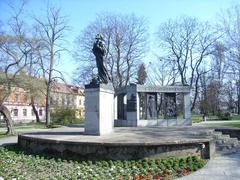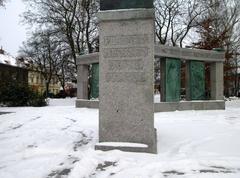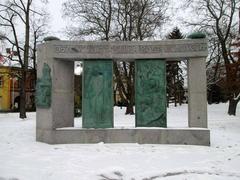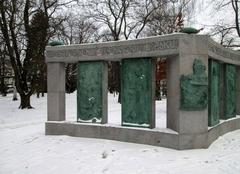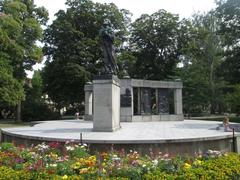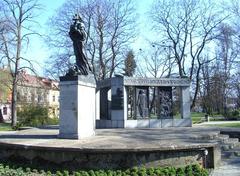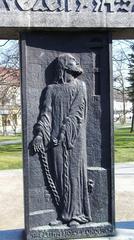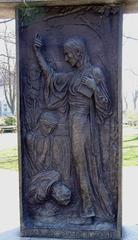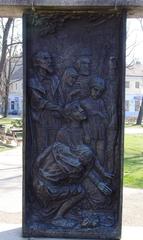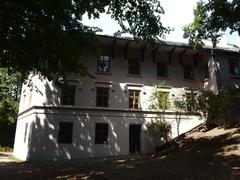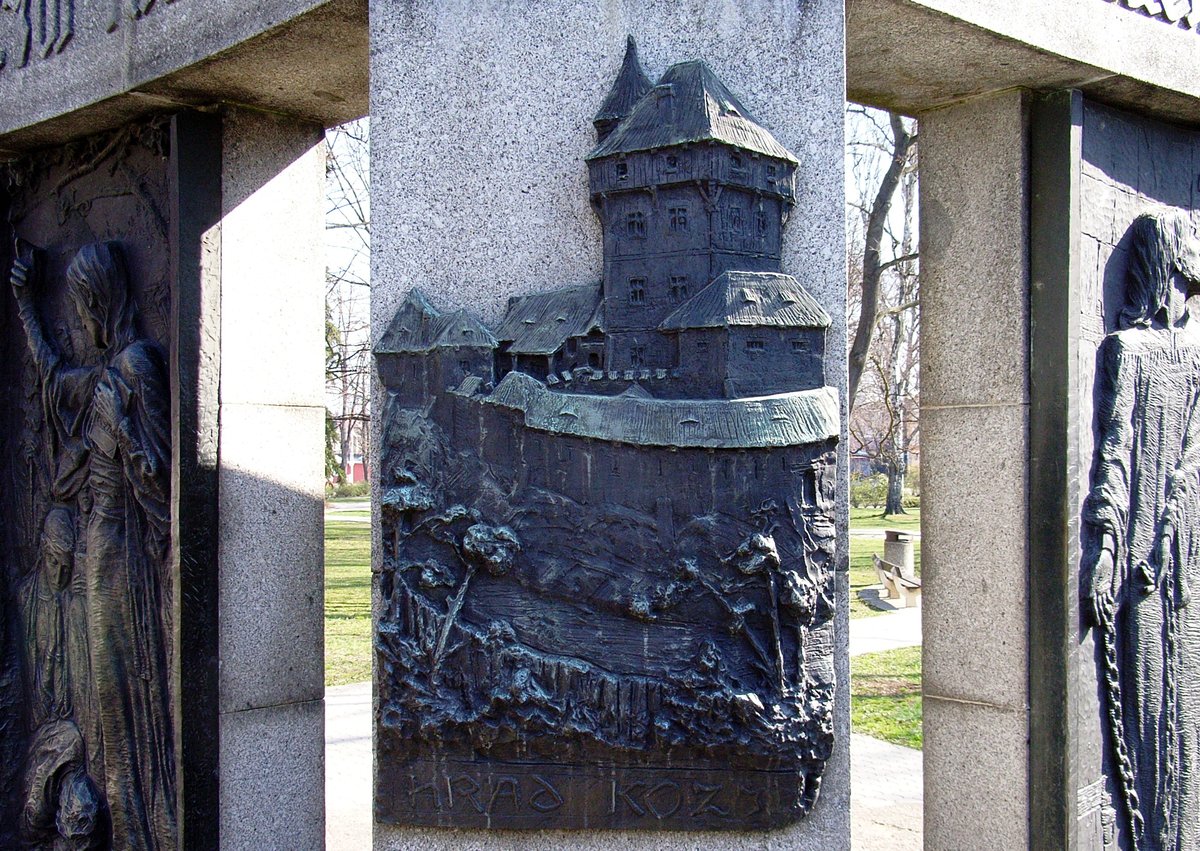
Visiting the Monument to Jan Hus in Tábor, Czechia: A Comprehensive Guide
Date: 14/06/2025
Introduction
The Monument to Jan Hus in Tábor is more than just a public statue—it’s a powerful symbol of Czech religious reform, resilience, and national pride. Situated in the heart of Tábor, South Bohemia, this landmark offers visitors a tangible connection to the dramatic events and ideals of the Hussite movement, which shaped the region’s identity and left a lasting mark on European history. Whether you are a history enthusiast, a cultural explorer, or a casual traveler, this guide will provide you with everything you need to know about the monument’s historical context, artistic significance, visitor logistics, and ways to enrich your experience in Tábor.
Table of Contents
- Introduction
- Historical Background: Jan Hus and the Hussite Movement
- The Monument: Description and Symbolism
- Visitor Information
- Other Tábor Historical Sites
- Frequently Asked Questions (FAQ)
- Conclusion and Travel Tips
- References
Historical Background: Jan Hus and the Hussite Movement
Jan Hus: Life, Teachings, and Legacy
Jan Hus (c. 1372–1415) was a Czech priest, philosopher, and early reformer whose critiques of the Catholic Church’s abuses and advocacy for religious and social reform made him a national hero. Influenced by John Wycliffe, Hus called for a return to authentic Christianity, denouncing corruption, the sale of indulgences, and clerical privilege (Czech Journal). His insistence on preaching in Czech gave his message broad appeal.
Summoned to the Council of Constance under a promise of safe conduct, Hus was arrested, tried for heresy, and burned at the stake on July 6, 1415. His martyrdom galvanized his followers and sparked the Hussite movement—a revolution that would profoundly shape Czech society (Jacobin).
Tábor: Birthplace of a Revolution
Founded in 1420 by Hus’s followers, Tábor became the headquarters of the radical Hussite faction known as the Táborites. The town was designed around egalitarian principles, communal ownership, and a rejection of both feudal and church authorities. The Hussite Wars (1419–1434) saw Tábor’s citizens employ innovative military tactics and fortifications, some of which remain visible in the town’s architecture and underground tunnels (Tourist Places Guide). Tábor’s role as a center of reform and resistance is still celebrated today, especially each July 6 on the anniversary of Hus’s execution.
The Monument: Description and Symbolism
Artistic Features
The Monument to Jan Hus stands in Hus Park (Husův park), near Tábor’s historic center. Created by acclaimed Czech sculptor František Bílek and unveiled in 1928 (marking 500 years since Hus’s death), the statue depicts Hus in a contemplative pose, holding a Bible. The inscription “Plameny směřují k pravdě” (“Flames move towards truth”) references Hus’s execution by burning and his unwavering quest for truth (visittabor.eu).
The monument’s flowing Art Nouveau lines and expressive detail reflect Bílek’s spiritual vision, inviting visitors to pause and consider the enduring struggle for conscience and reform.
Cultural Significance
The monument is a focal point for commemorations, especially on July 6, and stands as a testament to the Czech struggle for religious and political autonomy. Its location in Tábor—a town itself born of the Hussite ideal—adds layers of meaning, making it a site of both historical memory and ongoing civic pride (Sacred Czech).
Visitor Information
Location
- Address: Hus Park (Husův park), Tábor, Czechia
- Nearby: Žižka Square, Old Town, Hussite Museum, Church of the Transfiguration
Tábor is approximately 90–100 km south of Prague and easily accessible by train or bus (travel time: 1.5–2 hours). The monument is a short walk from the train station and centrally located for exploring other sites (Wikivoyage; laidbacktrip.com).
Visiting Hours and Tickets
- Monument Hours: Open-air site, accessible 24/7, year-round
- Admission: Free; no tickets required
Hussite Museum & Underground Tunnels
-
Museum Hours:
- April–October: Tue–Sun, 9:00–17:00
- November–March: Tue–Sun, 10:00–16:00
- Closed Mondays and public holidays
-
Ticket Prices:
- Adults: 120 CZK
- Students/Seniors: 80 CZK
- Children under 6: Free
- Family and group discounts available (Hussite Museum)
-
Underground Tunnels Tours: April–October, 45-minute guided tours (100 CZK/person, advance booking recommended).
Guided Tours and Events
The Tábor Tourist Information Centre (Žižka Square 2) offers maps, brochures, and organizes guided walking tours including the monument, Hussite Museum, and underground tunnels (visittabor.eu). Annual events—especially Hus Day (July 6) and the Tábor Meetings festival—feature ceremonies and cultural performances at the monument.
Amenities and Accessibility
- Accessibility: The park and monument are wheelchair-friendly; benches and shaded areas are available.
- Restrooms: Available near the main squares and the Hussite Museum.
- Dining: Cafés and restaurants surround the area, offering Czech and international cuisine.
- Shops: Souvenirs, books, and local crafts are available nearby.
- Safety: Tábor is generally safe; standard travel precautions apply.
Other Tábor Historical Sites
- Žižka Square: Named after Hussite commander Jan Žižka, lined with Gothic and Renaissance buildings.
- Hussite Museum: Interactive exhibits on Hus, the Hussite Wars, and medieval Tábor.
- Underground Tunnels: Explore defensive passages beneath the city.
- Kotnov Tower and Bechyňská Gate: Remnants of medieval fortifications with panoramic views.
- Lake Jordán: Oldest reservoir in Central Europe, ideal for walks and relaxation.
Frequently Asked Questions (FAQ)
Q: What are the visiting hours for the Monument to Jan Hus?
A: The monument is accessible 24 hours a day, year-round, and is free to visit.
Q: Are tickets required?
A: No tickets are needed for the monument. Tickets are required for the Hussite Museum and underground tours.
Q: Is the site accessible for visitors with limited mobility?
A: Yes, Hus Park is flat and wheelchair accessible.
Q: Are guided tours available?
A: Yes, guided walking tours are available through the Tábor Tourist Information Centre and the Hussite Museum.
Q: What is the best time to visit?
A: Late spring to early autumn (May–September) offers pleasant weather and cultural events. July 6 is particularly special for Hus Day commemorations.
Q: Can I take photos at the monument?
A: Yes, photography is welcome. Early morning and late afternoon provide the best lighting.
Conclusion and Travel Tips
The Monument to Jan Hus in Tábor offers a unique window into Czech history, religious reform, and enduring ideals of justice and liberty. Freely accessible in a tranquil park setting, the monument is an essential stop for any visitor to South Bohemia. Enhance your visit by exploring the adjoining Hussite Museum, medieval tunnels, and the charming old town, or plan your trip during festivals for an immersive experience.
References
- The Hussite Era, Its Influence on Czech Fortifications and Castles, 2024, Czech Journal (Czech Journal)
- Hussite Revolt and Reformation, 2024, Jacobin (Jacobin)
- The Hussite Museum, Visit Tábor (Hussite Museum)
- Tábor Travel Guide - Top 10 Must Visit Tourist Places, Tourist Places Guide (Tourist Places Guide)
- Tabor - The Hussite Town, Sacred Czech Tours (Sacred Czech)
- Monument to Master Jan Hus, Visit Tábor (visittabor.eu)
- Tabor - The Town of Hussite History, South Bohemia (jiznicechy.cz)
- Visiting Tábor: Hussite History and Attractions, Laidback Trip (laidbacktrip.com)
- Prague FM - Visiting Tábor (prague.fm)
- Living Prague - Jan Hus Monument (livingprague.com)
- Wikivoyage - Tábor (Wikivoyage)
- Hussite Museum Official Website (Hussite Museum)
- Tabor.cz - Official Tourist Information (Tabor.cz)


